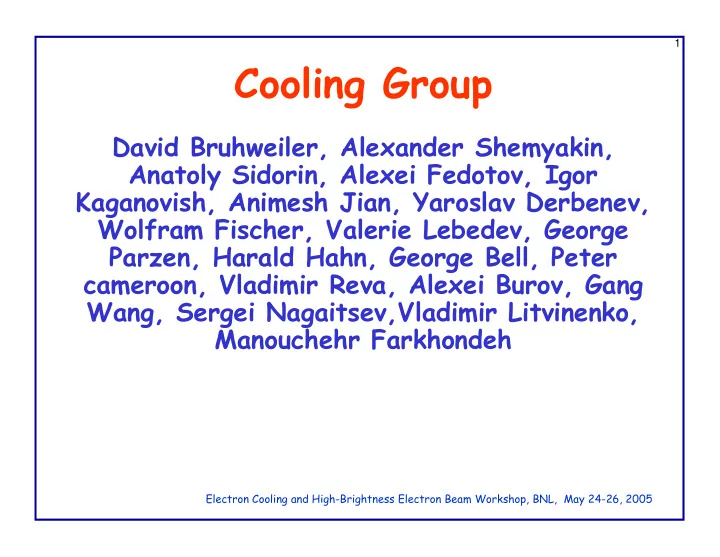

1 Cooling Group David Bruhweiler, Alexander Shemyakin, Anatoly Sidorin, Alexei Fedotov, Igor Kaganovish, Animesh Jian, Yaroslav Derbenev, Wolfram Fischer, Valerie Lebedev, George Parzen, Harald Hahn, George Bell, Peter cameroon, Vladimir Reva, Alexei Burov, Gang Wang, Sergei Nagaitsev,Vladimir Litvinenko, Manouchehr Farkhondeh Electron Cooling and High-Brightness Electron Beam Workshop, BNL, May 24-26, 2005
2 Workgroup charge • Establish the degree of confidence and accuracy we have in the simulations and theory of non-magnetized electron cooling. Examine the performance of this cooling technique for RHIC and evaluate potential difficulties. Establish a plan for continues R&D. Electron Cooling and High-Brightness Electron Beam Workshop, BNL, May 24-26, 2005
3 E-Cooling Modelling • VORPAL and Beta-cool codes appear to be adequate to describe the cooling process correctly. They serve different purposes. • Main uncertainties in FNAL RR cooler come from uncertainties in electron beam parameters • Effects of undulator on the cooling are treated adequately in the VORPAL and Beta-cool • Effect of arbitrary (with constrains on field integral) dipole field errors along the cooling section on cooling should be studied by VORPAL – Coulomb log vs. temperature Electron Cooling and High-Brightness Electron Beam Workshop, BNL, May 24-26, 2005
4 Recombination and Undulator • There is uncertainty in recombination rates at low ion- electron velocities for a given electron temperature • There is no clear understanding of this discrepancy – Recombination seems not a problem for RHIC cooler (and causes 17% loss in integrated luminosity) with following caveats • Undulator (8 cm, 10 Gs) definitely suppresses the recombination by at least an order of magnitude • Undulator design seems to be straight forward and does satisfy requirements for the field accuracy Electron Cooling and High-Brightness Electron Beam Workshop, BNL, May 24-26, 2005
5 GSI: recombination suppression with transverse electron angle Electron Cooling and High-Brightness Electron Beam Workshop, BNL, May 24-26, 2005
6 Two-beam instabilities In-hand models for two-beam instabilities are adequate • RHIC cooler is orders of magnitude below instability thresholds • (for 5 nC and 1 cm long e-beam) It seems that there is no need for e-bunch stretcher • Studies are needed to see if there is influence of short e- • bunches on synchro-betatron resonance for hadrons Instability may occur for coolers with magnetized beams and • solenoidal field Potential explanation of FNAL RR emittance growth is developed • by Burov (envelope oscillations) Princeton has a program which can be used to simulate emittance • growth in FNAL RR Electron Cooling and High-Brightness Electron Beam Workshop, BNL, May 24-26, 2005
7 Additional Points Consider electron and ion trapping by both electron and ion • (hadron) and related space charge effects Study influence of bunch-to-bunch charge and position • variations in e-beam on emittance of hadron beam. Effect of arbitrary field errors along the cooling section on • cooling Study sensitivity to errors in: transport channel, PS ripple, • hysteresis effects, hadron bunch charge variation, etc. on matching of electron beam into the cooling sections (especially on the second pass) Space charge defocusing in cooling section must be counteracted • by distributed short focusing solenoids (10 m apart, F ~ 1km). Study optimal spacing of lenses. Also study effects of non- uniform density profile on the defocusing effects. Put together a budget of angular errors a-la RR-cooler • Investigate influence of transverse wake-fields of miss-aligned • beams in the cooling sections (resistive wall and other impedances) Electron Cooling and High-Brightness Electron Beam Workshop, BNL, May 24-26, 2005
8 Possible Experiments • Measure drag force at RR for currents from 0 to 100 mA • Understand better properties of electron beam in RR cooler • Test technique of drag force measurement by exiting coherent synchrotron oscillations by modulating e-beam energy with synchrotron frequency Electron Cooling and High-Brightness Electron Beam Workshop, BNL, May 24-26, 2005
9 Instrumentation • The diagnostics plan presented seemed adequate • Suggest to separate instrumentation into two parts: – Needed only for commissioning – Operational Electron Cooling and High-Brightness Electron Beam Workshop, BNL, May 24-26, 2005
10 Conclussions • Very encouraged by the degree of detailed studies and analysis. • We did not find any show- stoppers in the cooling scenario for the presented RHIC cooler design. Electron Cooling and High-Brightness Electron Beam Workshop, BNL, May 24-26, 2005
Recommend
More recommend